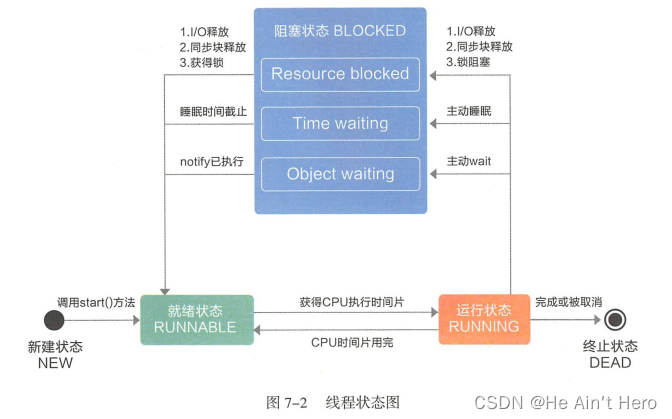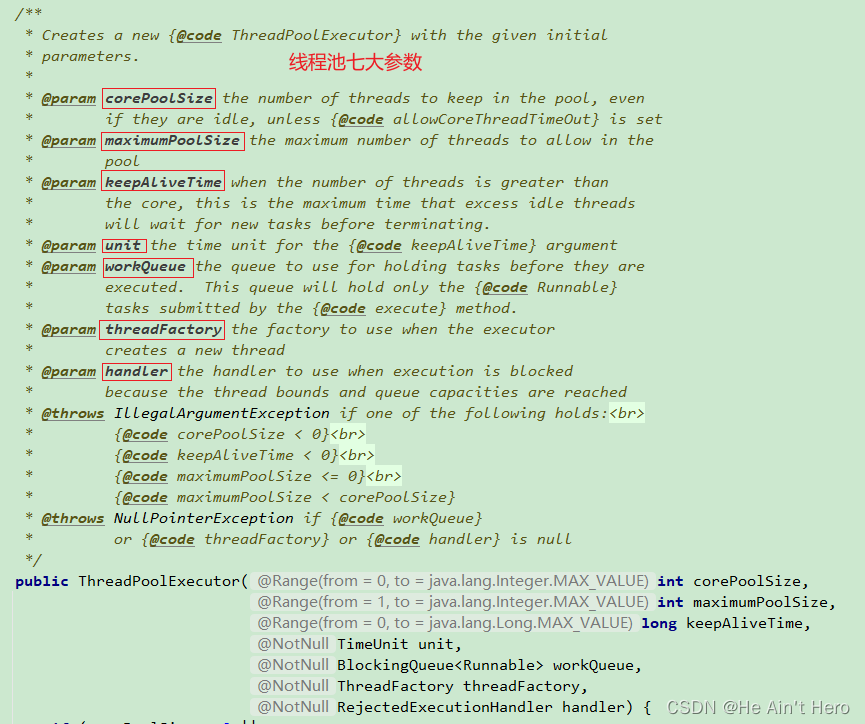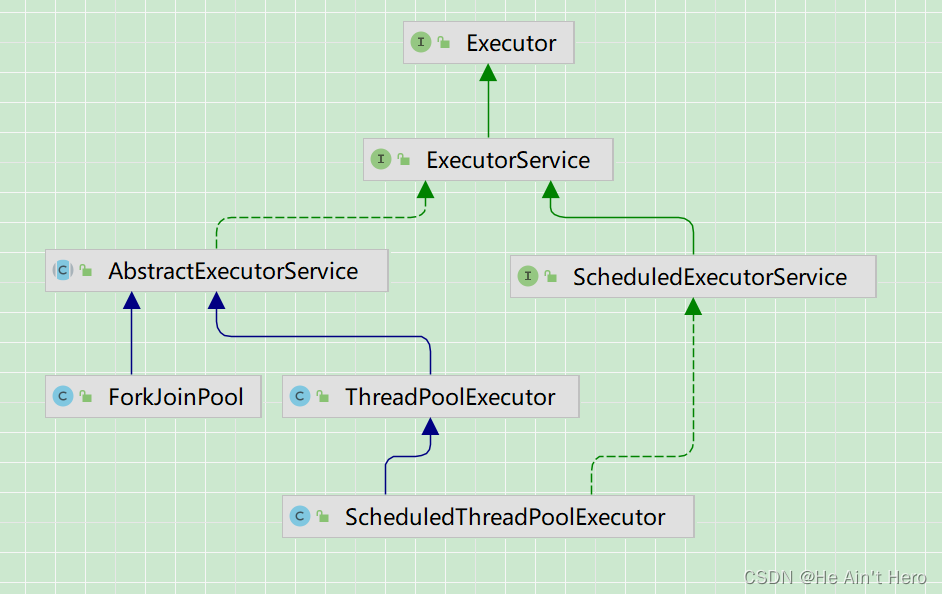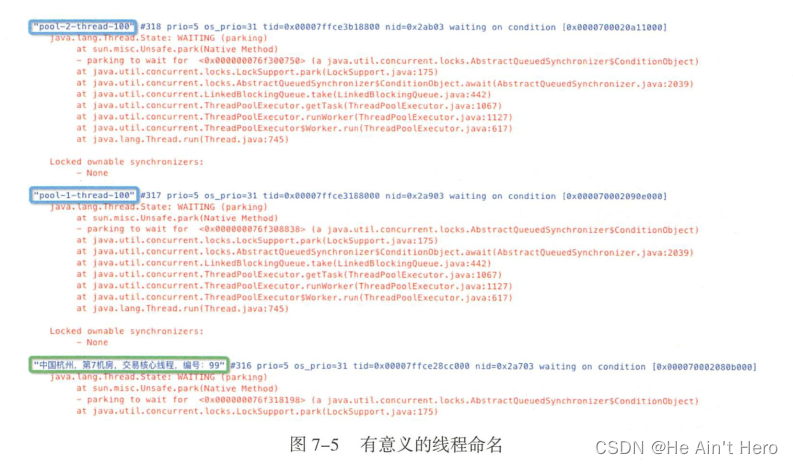网站建设市场推广招聘seo优化排名营销
码出高效:Java开发手册笔记(线程池及其源码)
码出高效:Java开发手册笔记(线程池及其源码)
- 码出高效:Java开发手册笔记(线程池及其源码)
- 前言
- 一、线程池的作用
- 线程的生命周期
- 二、线程池7大参数
- execute() 与 submit()
- Executors 静态工厂方法创建线程池
- 自定义实现线程工厂 ThreadFactory
- 自定义线程池拒绝策略 实现*RejectedExecutionHandler*
- 线程池拒绝策略
- 三、线程池源码详解
- 总结
前言
线程池
一、线程池的作用
线程使应用能够更加充分合理地协调利用 CPU、内存、网络、 I/O 等系统资源。线程的创建需要开辟虚拟机栈、本地方法栈、程序计数器等线程私有的内存空间。在线程销毁时需要回收这些系统资源。频繁地创建和销毁线程会浪费大量的系统资源,增加并发编程风险。另外,在服务器负载过大的时候,如何让新的线程等待或者友好地拒绝服务?这些都是线程自身无法解决的。所以需要通过线程池协调多个线程 , 并实现类似主次线程隔离、定时执行、周期执行等任务。线程池的作用包括:
- 利用线程池管理并复用线程、控制最大并发数等。
- 实现任务线程队列缓存策略和拒绝机制。
- 实现某些与时间相关的功能,如定时执行、周期执行等。
- 隔离线程环境。比如,交易服务和搜索服务在同一台服务器上,分别开启两个线程池,交易线程的资源消耗明显要大;因此,通过配置独立的线程池 ,将较慢的交易服务与搜索服务隔离开,避免各服务线程相互影响。
线程的生命周期

线程池重要的参数,ctl,是一个包含两个属性的原子整型;一个属性是 workerCount,指的是有效线程数;另一个是 runState,指的是线程的状态(线程的生命周期)
/*** The workerCount is the number of workers that have been* permitted to start and not permitted to stop. The value may be* transiently different from the actual number of live threads,* for example when a ThreadFactory fails to create a thread when* asked, and when exiting threads are still performing* bookkeeping before terminating. The user-visible pool size is* reported as the current size of the workers set.*//*** The runState provides the main lifecycle control, taking on values:** RUNNING: Accept new tasks and process queued tasks* SHUTDOWN: Don't accept new tasks, but process queued tasks* STOP: Don't accept new tasks, don't process queued tasks,* and interrupt in-progress tasks* TIDYING: All tasks have terminated, workerCount is zero,* the thread transitioning to state TIDYING* will run the terminated() hook method* TERMINATED: terminated() has completed*/// runState is stored in the high-order bitsprivate static final int RUNNING = -1 << COUNT_BITS;private static final int SHUTDOWN = 0 << COUNT_BITS;private static final int STOP = 1 << COUNT_BITS;private static final int TIDYING = 2 << COUNT_BITS;private static final int TERMINATED = 3 << COUNT_BITS;

Thread类中的线程生命周期
public enum State {/*** Thread state for a thread which has not yet started.*/NEW,/*** Thread state for a runnable thread. A thread in the runnable* state is executing in the Java virtual machine but it may* be waiting for other resources from the operating system* such as processor.*/RUNNABLE,/*** Thread state for a thread blocked waiting for a monitor lock.* A thread in the blocked state is waiting for a monitor lock* to enter a synchronized block/method or* reenter a synchronized block/method after calling* {@link Object#wait() Object.wait}.*/BLOCKED,/*** Thread state for a waiting thread.* A thread is in the waiting state due to calling one of the* following methods:* <ul>* <li>{@link Object#wait() Object.wait} with no timeout</li>* <li>{@link #join() Thread.join} with no timeout</li>* <li>{@link LockSupport#park() LockSupport.park}</li>* </ul>** <p>A thread in the waiting state is waiting for another thread to* perform a particular action.** For example, a thread that has called <tt>Object.wait()</tt>* on an object is waiting for another thread to call* <tt>Object.notify()</tt> or <tt>Object.notifyAll()</tt> on* that object. A thread that has called <tt>Thread.join()</tt>* is waiting for a specified thread to terminate.*/WAITING,/*** Thread state for a waiting thread with a specified waiting time.* A thread is in the timed waiting state due to calling one of* the following methods with a specified positive waiting time:* <ul>* <li>{@link #sleep Thread.sleep}</li>* <li>{@link Object#wait(long) Object.wait} with timeout</li>* <li>{@link #join(long) Thread.join} with timeout</li>* <li>{@link LockSupport#parkNanos LockSupport.parkNanos}</li>* <li>{@link LockSupport#parkUntil LockSupport.parkUntil}</li>* </ul>*/TIMED_WAITING,/*** Thread state for a terminated thread.* The thread has completed execution.*/TERMINATED;
}
在了解线程池的基本作用后,我们学习一下线程池是如何创建线程的。首先从 ThreadPoolExecutor 构造方法讲起 , 学习如何自定义 ThreadFactory 和RejectedExecutionHandler , 并编写一个最简单的线程池示例。然后,通过分析ThreadPoolExecutor 的 execute 和 addWorker 两个核心方法,学习如何把任务线程加入到线程池中运行。 ThreadPoolExecutor 的构造方法如下:

二、线程池7大参数
public ThreadPoolExecutor(int corePoolSize, //(第一个参数)int maximumPoolSize, //(第二个参数)long keepAliveTime, //(第三个参数)TimeUnit unit, //(第四个参数)BlockingQueue<Runnable> workQueue, //(第五个参数)ThreadFactory threadFactory, //(第六个参数)RejectedExecutionHandler handler) { //(第七个参数)if (corePoolSize < 0 ||// maximumPoolSize必须大于或等于1也要大于或等于corePoolSize (第1处)maximumPoolSize <= 0 ||maximumPoolSize < corePoolSize ||keepAliveTime < 0)throw new IllegalArgumentException();// (第2处)if (workQueue == null || threadFactory == null || handler == null)throw new NullPointerException();this.corePoolSize = corePoolSize;this.maximumPoolSize = maximumPoolSize;this.workQueue = workQueue;this.keepAliveTime = unit.toNanos(keepAliveTime);this.threadFactory = threadFactory;this.handler = handler;
}
第 1 个参数:corePoolSize 表示常驻核心线程数。如果等于 0 ,则任务执行完之后 ,没有任何请求进入时销毁线程池的线程;如果大于 0 ,即使本地任务执行完毕,核心线程也不会被销毁。这个值的设置非常关键,设置过大会浪费资源,设置过小会导致线程频繁地创建或销毁。
第 2 个参数: maximumPoolSize 表示线程池能够容纳同时执行的最大线程数。从上方示例代码中的第 1 处来看,必须大于或等于 1。如果待执行的线程数大于此值,需要借助第 5 个参数的帮助,缓存在队列中。如果 maximumPoolSize 与 corePoolSize相等,即是固定大小线程池。
第 3 个参数: keepAliveTime 表示线程池中的线程空闲时间,当空闲时间达到 keepAliveTime 值时,线程会被销毁,直到只剩下 corePoolSize 个线程为止,避免浪费内存和句柄资源。在默认情况下,当线程池的线程数大于 corePoolSize 时,keepAliveTime 才会起作用。但是当 ThreadPoolExecutor 的 allowCoreThreadTimeOut变量设置为 true 时 , 核心线程超时后也会被回收。
第 4 个参数:TimeUnit 表示时间单位。 keepAliveTime 的时间单位通常是TimeUnit.SECONDS 。
第 5 个参数: workQueue 表示缓存队列。当请求的线程数大于 maximumPoolSize时 , 线程进入 BlockingQueue 阻塞队列。后续示例代码中使用的 LinkedBlockingQueue是单向链表,使用锁来控制入队和出队的原子性,两个锁分别控制元素的添加和获取,是一个生产消费模型队列。
第 6 个参数: threadFactory 表示线程工厂。它用来生产一组相同任务的线程。线程池的命名是通过给这个 factory 增加组名前缀来实现的。在虚拟机栈分析时,就可以知道线程任务是由哪个线程工厂产生的。
第 7 个参数: handler 表示执行拒绝策略的对象。当超过第 5 个参数 workQueue的任务缓存区上限的时候,就可以通过该策略处理请求,这是 种简单的限流保护。像某年双十一没有处理好访问流量过载时的拒绝策略,导致内部测试页面被展示出来,使用户手足无措。友好的拒绝策略可以是如下三种:
( 1 )保存到数据库进行削峰填谷。在空间时再提取出来执行。
( 2 )转向某个提示页由。
( 3 )打印日志。
从代码第 2 处来看 , 队列、线程工厂、拒绝处理服务都必须有实例对象 , 但在实际编程中,很少有程序员对这三者进行实例化,而通过 Executors 这个线程池静态工厂提供默认实现 , 那么 Exceutors 与 ThreadPoolExecutor 是什么关系呢?线程池相关类图如下图所示。

execute() 与 submit()
execute为ThreadPoolExecutor里的方法,没有返回值
/*** @param 线程任务* @throws RejectedExecutionException 如果无法创建任何状态的线程任务* /
void execute (Runnable command );
submit为AbstractExecutorService里的方法,有返回值
public Future<?> submit(Runnable task) {if (task == null) throw new NullPointerException();RunnableFuture<Void> ftask = newTaskFor(task, null);execute(ftask);return ftask;
}
Executors 静态工厂方法创建线程池
ExecutorService 接口继承了 Executor 接口,定义了管理线程任务的方法。ExecutorService 的抽象类 AbstractExecutorService 提供了 submit() 、 invokeAll() 等部分方法的实现 , 但是核心方法Executor.execute() 并没有在这里实现。因为所有的任务都在这个方法里执行 , 不同实现会带来不同的执行策略,这点在后续的 ThreadPoolExecutor 解析时 ,会一步步地分析。通过Executors 的静态工厂方法可以创建三个线城池的包装对象。 ForkJoinPool 、 ThreadPooIExecutor、ScheduledThreadPoolExecutor 。 Executors 核心的方法有五个:
- Executors.newWorkStealingPool: JDK8 引人,创建持有足够线程的线程池支持给定的并行度 , 并通过使用多个队列减少竞争 , 此构造方法中把 CPU 数量设置为默认的并行度:
/*** Creates a work-stealing thread pool using all* {@link Runtime#availableProcessors available processors}* as its target parallelism level.* @return the newly created thread pool* @see #newWorkStealingPool(int)* @since 1.8*/public static ExecutorService newWorkStealingPool() {// 返回 ForkJoinPool(JDK7引入)对象,它也是 AbstractExecutorService 的子类return new ForkJoinPool(Runtime.getRuntime().availableProcessors(),ForkJoinPool.defaultForkJoinWorkerThreadFactory,null, true);}
- Executors.newCachedThreadPool: maximumPoolSize 最大可以至 Integer.MAX_VALUE, 是高度可伸缩的线程池 ,如果达到这个上限 , 相信没有任何服务器能够继续工作,肯定会抛出 OOM 异常。 keepAliveTime 默认为 60 秒,工作线程处于空闲状态 , 则回收工作线程。如果任务数增加 ,再次创建出新线程处理任务。
- Executors.newScheduledThreadPool:线程数最大至 Integer.MAX_VALUE,与上述相同,存在 OOM 风险。它是ScheduledExecutorService 接口家族的实现类,支持定时及周期性任务执行。相 比 Timer , ScheduledExecutorService 更安全,功能更强大,与 newCachedThreadPool 的区别是不回收工作线程。
- Executors.newSingleThreadExecutor : 创建一个单线程的线程池,相当于单线程串行执行所有任务,保证按任务的提交顺序依次执行。
- Executors.newFixedThreadPool : 输入的参数即是固定线程数,既是核心线程数也是最大线程数 , 不存在空闲线程,所以keepAliveTime 等于 0:
/*** Creates a thread pool that reuses a fixed number of threads* operating off a shared unbounded queue. At any point, at most* {@code nThreads} threads will be active processing tasks.* If additional tasks are submitted when all threads are active,* they will wait in the queue until a thread is available.* If any thread terminates due to a failure during execution* prior to shutdown, a new one will take its place if needed to* execute subsequent tasks. The threads in the pool will exist* until it is explicitly {@link ExecutorService#shutdown shutdown}.** @param nThreads the number of threads in the pool* @return the newly created thread pool* @throws IllegalArgumentException if {@code nThreads <= 0}*/public static ExecutorService newFixedThreadPool(int nThreads) {return new ThreadPoolExecutor(nThreads, nThreads,0L, TimeUnit.MILLISECONDS,new LinkedBlockingQueue<Runnable>());}
这里 , 输入的队列没有指明长度,下面介绍 LinkedBlockingQueue 的构造方法:
/*** Creates a {@code LinkedBlockingQueue} with a capacity of* {@link Integer#MAX_VALUE}.*/public LinkedBlockingQueue() {this(Integer.MAX_VALUE);}
使用这样的无界队列, 如果瞬间请求非常大 , 会有 OOM 的风险。除newWorkStealingPool 外 ,其他四个创建方式都存在资源耗尽的风险。
自定义实现线程工厂 ThreadFactory
Executors 中默认的线程工厂和拒绝策略过于简单,通常对用户不够友好。线程工厂需要做创建前的准备工作,对线程池创建的线程必须明确标识,就像药品的生产批号一样,为线程本身指定有意义的名称和相应的序列号。拒绝策略应该考虑到业务场景,返回相应的提示或者友好地跳转。以下为简单的 ThreadFactory 示例:
package com.example.demo.test1;import java.util.concurrent.ThreadFactory;
import java.util.concurrent.atomic.AtomicInteger;/*** @Author: Ron* @Create: 2023-04-24 15:07*/
public class UserThreadFactory implements ThreadFactory {private final String namePrefix;private final AtomicInteger nextId = new AtomicInteger(1);// 定义线程组名称,在使用jstack来排查线程问题时,可以通过线程组名称来快速定位问题UserThreadFactory(String whatFeatureOfGroup) {namePrefix = "From UserThreadFactory's " + whatFeatureOfGroup + "-Worker-";}@Overridepublic Thread newThread(Runnable task) {String name = namePrefix + nextId.getAndIncrement();Thread thread = new Thread(null, task, name, 0);
// System.out.println(thread.getName());return thread;}
}
上述示例包括线程工厂和任务执体的定义 , 通过 newThread 方法快速、统一地创建线程任务,强调线程一定要有特定意义的名称,方便出错时回溯。
如图 7-5 所示为排查底层公共缓存调用出错时的截图,绿色框采用自定义的线程工厂,明显比蓝色框默认的线程工厂创建的线程名称拥有更多的额外信息 。 如调用来源、线程的业务含义,有助于快速定位到死锁、 StackOverflowError 等问题。

自定义线程池拒绝策略 实现RejectedExecutionHandler
下面再简单地实现一下 RejectedExecutionHandler,实现了接口的 rejectedExecution方法,打印出当前线程池状态,源码如下:
package com.example.demo.test1;import java.util.concurrent.RejectedExecutionHandler;
import java.util.concurrent.ThreadPoolExecutor;/*** @Author: Ron* @Create: 2023-04-24 15:48*/
public class UserRejectHandler implements RejectedExecutionHandler {@Overridepublic void rejectedExecution(Runnable task, ThreadPoolExecutor executor) {System.out.println("Task rejected from " + executor.toString());// 可以将task存入队列,等空闲时再去执行}
}
线程池拒绝策略
在ThreadPoolExecutor 中提供了四个公开的内部静态类:
- AbortPolicy (默认):丢弃任务并抛出 RejectedExecutionException 异常。
- DiscardPolicy : 丢弃任务,但是不抛出异常 , 这是不推荐的做法。
- DiscardOldestPolicy : 抛弃队列中等待最久的任务 , 然后把当前任务加入队列中。
- CallerRunsPolicy :调用任务的 run() 方法绕过线程池直接执行,使用调用线程执行任务。
new ThreadPoolExecutor.AbortPolicy(); // 默认,队列满了丢弃任务并抛出异常new ThreadPoolExecutor.CallerRunsPolicy(); // 如果添加线城池失败,使用调用线程执行任务new ThreadPoolExecutor.DiscardOldestPolicy(); // 将最早进入队列的任务删除,之后尝试加入队列new ThreadPoolExecutor.DiscardPolicy(); // 队列满了,丢弃任务不抛出异常
根据之前实现的线程工厂和拒绝策略,线程池的相关代码实现如下:
package com.example.demo.test1;import java.util.concurrent.BlockingQueue;
import java.util.concurrent.LinkedBlockingQueue;
import java.util.concurrent.ThreadPoolExecutor;
import java.util.concurrent.TimeUnit;/*** @Author: Ron* @Create: 2023-04-24 15:59*/
public class UserThreadPool {public static void main(String[] args) {// 缓存队列设置固定长度为2,为了快速触发 rejectHandlerBlockingQueue queue = new LinkedBlockingQueue(2);// 假设外部任务线程的来源由机房1和机房2的混合调用UserThreadFactory f1 = new UserThreadFactory("第1机房");UserThreadFactory f2 = new UserThreadFactory("第2机房");// 自定义拒绝策略UserRejectHandler handler = new UserRejectHandler();// 核心线程为1,最大线程为2,为了保证触发rejectHandlerThreadPoolExecutor threadPoolFirst= new ThreadPoolExecutor(1, 2, 60,TimeUnit.SECONDS, queue, f1, handler);// 利用第二个线程工厂实力创建第二个线程池ThreadPoolExecutor threadPoolSecond= new ThreadPoolExecutor(1, 2, 60,TimeUnit.SECONDS, queue, f2, handler);// 创建400个任务线程Runnable task = new Task();for (int i = 0; i < 200; i++) {threadPoolFirst.execute(task);threadPoolSecond.execute(task);threadPoolSecond.submit(task);}}}执行结果如下:

当任务被拒绝的时候,拒绝策略会打印出当前线程池的大小已经达到了maximumPoolSize=2 ,且队列已满,完成的任务数提示已经有 4 个(最后一行)。
三、线程池源码详解
在 ThreadPoolExecutor 的属性定义中频繁地用位移运算来表示线程池状态, 位移运算是改变当前值的一种高效手段 , 包括左移与右移。下面从属性定义开始阅读ThreadPoolExecutor 的源码。
// Integer共有32位,最右边29位表示工作线程数,最左边3位表示线程池状态// 注:简单地说,3个二进制可以表示从0到7共8个不同的数值(第1处)private static final int COUNT_BITS = Integer.SIZE - 3;// 000-11111...1111(29个1),类似于子网掩码,用于位的与运算// 得到左边3位,还是右边29位private static final int CAPACITY = (1 << COUNT_BITS) - 1;// runState is stored in the high-order bits// 用左边3位,实现5种线程池状态。(在左3位之后加入中画线有助于理解)// 111-00000...0000(29个0),十进制值,-536,870,912// 此状态表示线程池能接受新任务private static final int RUNNING = -1 << COUNT_BITS;// 000-00000...0000(29个0),十进制值:0// 此状态不再接受新任务,但可以继续执行队列中的任务private static final int SHUTDOWN = 0 << COUNT_BITS;// 001-00000...0000(29个0),十进制值:536,870,912// 此状态全面拒绝,并中断正在处理的任务private static final int STOP = 1 << COUNT_BITS;// 010-00000...0000(29个0),十进制值:1,073,741,824// 此状态表示所有任务已经被终止private static final int TIDYING = 2 << COUNT_BITS;// 011-00000...0000(29个0),十进制值:1,610,612,736// 此状态表示已清理完现场private static final int TERMINATED = 3 << COUNT_BITS;// Packing and unpacking ctl// 与运算,比如 001-00000...0000(29个0),表示67个工作线程// 掩码取反: 111-00000...0000(29个0),即得到左边3位001// 表示线程池当前出于STOP状态private static int runStateOf(int c) { return c & ~CAPACITY; }// 同理掩码 000-11111...1111(29个1),得到右边29位,即工作线程数private static int workerCountOf(int c) { return c & CAPACITY; }// 把左边3位与右边29位按或运算,合并成一个值private static int ctlOf(int rs, int wc) { return rs | wc; }第 l :处说明 , 线程池的状态用高 3 位表示,其中包括了符号位。五种状态的
十进制值按从小到大依次排序为 RUNNING < SHUTDOWN < STOP < TIDYING <
TERMINATED , 这样设计的好处是可以通过比较值的大小来确定线程池的状态。例
如程序中经常会出现 isRunning 的判断
private static boolean isRunning(int c) {return c < SHUTDOWN;
}
我们都知道 Executor 接口有且只有一个方法 execute , 通过参数传入待执行线程的对象。下面分析 ThreadPoolExecutor 关于 execute 方法的实现,
/*** Executes the given task sometime in the future. The task* may execute in a new thread or in an existing pooled thread.** If the task cannot be submitted for execution, either because this* executor has been shutdown or because its capacity has been reached,* the task is handled by the current {@code RejectedExecutionHandler}.** @param command the task to execute* @throws RejectedExecutionException at discretion of* {@code RejectedExecutionHandler}, if the task* cannot be accepted for execution* @throws NullPointerException if {@code command} is null*/public void execute(Runnable command) {if (command == null)throw new NullPointerException();/** Proceed in 3 steps:** 1. If fewer than corePoolSize threads are running, try to* start a new thread with the given command as its first* task. The call to addWorker atomically checks runState and* workerCount, and so prevents false alarms that would add* threads when it shouldn't, by returning false.** 2. If a task can be successfully queued, then we still need* to double-check whether we should have added a thread* (because existing ones died since last checking) or that* the pool shut down since entry into this method. So we* recheck state and if necessary roll back the enqueuing if* stopped, or start a new thread if there are none.** 3. If we cannot queue task, then we try to add a new* thread. If it fails, we know we are shut down or saturated* and so reject the task.*/// 返回包含线程数及线程池状态的Integer类型数值int c = ctl.get();// 如果工作线程数小于核心线程数,则创建线程任务并执行if (workerCountOf(c) < corePoolSize) {// addWorker是另一个极为重要的方法,见下一段源码解析(第1处)if (addWorker(command, true))return;// 如果创建失败,防止外部已经在线程池中加入新任务,重新获取一下c = ctl.get();}// 只有线程池处于RUNNING状态,才执行后半句:置入队列if (isRunning(c) && workQueue.offer(command)) {int recheck = ctl.get();// 如果线程池不是RUNNING状态,则将刚加入队列的任务移除if (! isRunning(recheck) && remove(command))reject(command);// 如果之前的线程已被消费完,新建一个线程else if (workerCountOf(recheck) == 0)addWorker(null, false);}// 核心池和队列都已满,尝试创建一个新线程else if (!addWorker(command, false))// 如果addWorker返回是false,即创建失败,则唤醒拒绝策略(第2处)reject(command);}
第 1 处: execute 方法在不同的阶段有三次 addWorker 的尝试动作。
第 2 处: 发生拒绝的理由有两个
( 1 )线程池状态为非 RUNNING状态
( 2 )等待队列己满。
下面继续分析 addWorker 方法的源码:
/*** 根据当前线程池状态,检查是否可以添加新的任务线程,如果则创建并启动任务* 如果一切正常则返回true。返回false的可能性如下:* 1.线程池没有处于RUNNING状态* 2.线程工厂创建新的任务线程失败* @param firstTask 外部启动线程池是需要构造的第一个线程,他是线程的母体* @param core 新增工作线程时的判断指标,解释如下* true 表示新增工作线程时,需要判断当前RUNNING状态的线程是否少于corePoolSize* false 表示新增工作线程时,需要判断当前RUNNING状态的线程是否少于maximumPoolSize* @return*/private boolean addWorker(Runnable firstTask, boolean core) {// 不需要任务预定义的语法标签,响应下文的continue retry,快速退出多层嵌套循环(第1处)retry:for (;;) {// 参考之前的状态分析:如果RUNNING状态,则条件为假,不执行后面的判断// 如果是STOP及之上的状态,或者firstTask初始线程不为空,或者工作队列不为空,// 都会直接返回创建失败(第2处)int c = ctl.get();int rs = runStateOf(c);// Check if queue empty only if necessary.if (rs >= SHUTDOWN && ! (rs == SHUTDOWN && firstTask == null && ! workQueue.isEmpty()))return false;for (;;) {// 如果超过最大允许线程数则不能再添加新的线程// 最大线程数不能超过2^29,否则影响左边3位的线程池状态值int wc = workerCountOf(c);if (wc >= CAPACITY ||wc >= (core ? corePoolSize : maximumPoolSize))return false;// 将当前活动线程数+1 (第3处)if (compareAndIncrementWorkerCount(c))break retry;// 线程池状态和工作线程数是可变化的,需要经常提取这个最新值c = ctl.get(); // Re-read ctl// 如果已经关闭,则再次从retry标签处进入,在第2处再做判断 (第4处)if (runStateOf(c) != rs)continue retry;// else CAS failed due to workerCount change; retry inner loop// 如果线程还是处于RUNNING状态,那就在说明仅仅是第3处失败// 继续循环执行 (第5处)}}// 开始创建工作线程boolean workerStarted = false;boolean workerAdded = false;ThreadPoolExecutor.Worker w = null;try {// 利用Worker构造方法中的线程池工厂创建线程,并封装成工作线程Worker对象w = new ThreadPoolExecutor.Worker(firstTask);// 注意这是Worker中的属性对象thread (第6处)final Thread t = w.thread;if (t != null) {// 在进行ThreadPoolExecutor的敏感操作时// 都需要持有主锁,避免在添加和启动线程时被干扰final ReentrantLock mainLock = this.mainLock;mainLock.lock();try {// Recheck while holding lock.// Back out on ThreadFactory failure or if// shut down before lock acquired.int rs = runStateOf(ctl.get());// 当线程池状态为RUNNING或SHUTDOWN// 且firstTask初始线程为空时if (rs < SHUTDOWN ||(rs == SHUTDOWN && firstTask == null)) {if (t.isAlive()) // precheck that t is startablethrow new IllegalThreadStateException();workers.add(w);int s = workers.size();// 整个线程池在运行期间的最大并发任务个数if (s > largestPoolSize)largestPoolSize = s;workerAdded = true;}} finally {mainLock.unlock();}if (workerAdded) {// 终于看到亲切的start方法// 注意,并非线程池的execute的command参数指向的线程t.start();workerStarted = true;}}} finally {if (! workerStarted)// 线程启动失败,把刚才第3处加上的工作线程计数再减回去addWorkerFailed(w);}return workerStarted;}
这段代码晦涩难懂,部分地方甚至违反了代码规约,但其中蕴含的丰富的编码知识点值得我们去学习,下面接序号来依次讲解。
第 1 处, 配合循环语旬出现的 label ,类似于 goto 作用。 label 定义时,必须把标签和冒号的组合语旬紧紧相邻定义在循环体之前,否则会编译出错。目的是在实现多重循环时能够快速退出到任何一层。这种做法的出发点似乎非常贴心,但是在大型软件项目中 ,滥用标签行跳转的后果将是灾难性的。示例代码中,在 retry 下方有两个无限循环,在 workerCount 加 1 成功后,直接退出两层循环。
第 2 处,这样的表达式不利于代码阅读,应该改成:
Boolean isNotAllowedToCreateTask= runStateLeast(c, SHUTDOWN) && (runStateAtLeast(c, STOP)|| firstTask != null || workQueue.isEmpty());
if (isNotAllowedToCreateTask) {// ...
}
第 3 处, 与第 1 处的标签呼应 , Atomiclnteger 对象的加1操作是原子性的。break retry 表示直接跳出与 retry 相邻的这个循环体。
第 4 处,此 continue 跳转至标签处,继续执行循环。如果条件为假,则说明线程池还处于运行状态,即继续在 for( ;;)循环内执行。
第 5 处, compareAndlncrementWorkerCount 方法执行失败的概率非常低。即使失败 , 再次执行时成功的概率也是极高的,类似于自旋锁原理。这里的处理逻辑是先加 1,创建失败再减1,这是轻量处理并发创建线程的方式。如果先创建线程,成功再加1,当发现超出限制后再销毁线程,那么这样的处理方式明显比前者代价要大。
第 6 处 , Worker 对象是工作线程的核心类实现,部分源码如下:
/*** 它实现Runnable接口,并把本对象作为参数输入给run()方法中的runWorker(this),* 所以内部属性线程thread在start的时候,即会调用runWorker方法*/private final class Worker extends AbstractQueuedSynchronizer implements Runnable {/*** Creates with given first task and thread from ThreadFactory.* @param firstTask the first task (null if none)*/Worker(Runnable firstTask) {// 它是AbstractQueuedSynchronizer的方法// 在runWorker方法执行之前禁止线程被中断setState(-1); // inhibit interrupts until runWorkerthis.firstTask = firstTask;this.thread = getThreadFactory().newThread(this);}// 当thread被start()之后,执行runWorker的方法/** Delegates main run loop to outer runWorker */public void run() {runWorker(this);}}
总结
线程池的相关源码比较精炼,还包括线程池的销毁、任务提取和消费等,与线程状态图一样,线程池也有自己独立的状态转化流程,本节不再展开。总结一下,使用线程池要注意如下几点:
( 1 )合理设置各类参数,应根据实际业务场景来设置合理的工作线程数。
( 2 )线程资源必须通过线城池提供,不允许在应用中自行显式创建线程。
( 3 )创建线程或线城池时请指定有意义的线程名称,方便出错时回溯。
线程池不允许使用 Executors ,而是通过 ThreadPoolExecutor 的方式创建 ,这样的处理方式能更加明确线程池的运行规则,规避资源耗尽的风险。
